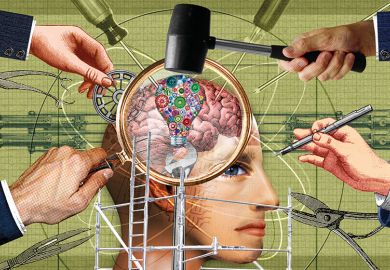When the universities minister, Sam Gyimah, came online with the Open University earlier this month, he was able to successfully use the Westminster wi-fi to connect first with a group of students and their tutor in an online tutorial, and then to move pretty much seamlessly to our OpenSTEM Labs to set lab-bench experiments and operate an electron microscope and analytical instruments located in our physical labs in Milton Keynes, virtually and in real time.
Not only did the technology work as intended, but the experience of speaking easily with students as they sat in their study spaces in far-flung villages, towns and cities powerfully conveyed the immense resilience and intellectual stamina required to study at a distance.
In a rapidly changing global higher education context, a host of disruptive technologies – such as artificial intelligence, 3D printing, smart devices, haptic devices and the remote, real-time access to research-grade scientific equipment that the minister witnessed – are changing the way in which every university, and indeed every organisation, is able to function and extend potential.
This is especially true for the OU, where access to state-of-the-art kit and carefully designed learning activities makes a rich academic experience available to all students, not just those in a position to study full time at a physical higher education location.
For me, the Sam Gyimah experience threw into sharp relief the characteristics of the worlds that collide when a person studies with us: the student world of studying in the margins of busy, often challenging lives – crossed with the arguably more abstract world of academia, innovation and ideas. Clearly, technology can play a powerful role in bridging these worlds, but only where they are properly understood and considered in the development of digital tools and curriculum.
The OU’s mission to be “open to people, places, methods and ideas” remains as relevant as ever. To continue to fulfil it successfully, we must ensure that we look to, and are led by, the needs of our students and staff.
To this end, the OU employs a “user-led” approach not just in shaping the UX/LX (user experience/learner experience) of our websites, but also in the design of our curriculum itself and of other student-facing learning and teaching systems and tools.
User-led learning design begins by properly understanding how our students want to study, or are going about studying right now, then seeks to use technology to make the student experience more intuitive. We use user focus groups, surveys (such as A Survey of the Learning Behaviours of Open University Students) and a curriculum design student panel comprised of more than 1,000 OU students.
This approach not only helps us to understand where technology can really add value from a student perspective, it ensures that we can systematically build skills and institutional capacity as we go.
For example, we have been experimenting with how to use our astonishingly rich big-data sets, alongside developing staff and student data and information capabilities, to improve the student experience. We have had some success, but we are not putting the cart before the horse. With the exception of OU Analyse, which is being used extensively, we are only now beginning to develop scaled tools to expose information to staff and students about progress and progression.
This is important because, if our understanding of our users’ needs and their potential capabilities gaps is not established with rigour and care, the impact of technological innovations (however sensible they sound) will be to frustrate, alienate and create unintended distance and inequalities among student and staff.
As important as it is to keep pace with technological innovation, we know that this must always be done in a way that ensures that our students connect in a meaningful way with their studies, their tutors – and with each other and the world around them. In spite of the changing, challenging context that higher education currently presents, university study must above all remain an experience to be cherished – with the odd ministerial visit thrown in.
Rebecca Galley is director of technology-enhanced learning at the Open University.
Register to continue
Why register?
- Registration is free and only takes a moment
- Once registered, you can read 3 articles a month
- Sign up for our newsletter
Subscribe
Or subscribe for unlimited access to:
- Unlimited access to news, views, insights & reviews
- Digital editions
- Digital access to THE’s university and college rankings analysis
Already registered or a current subscriber?




